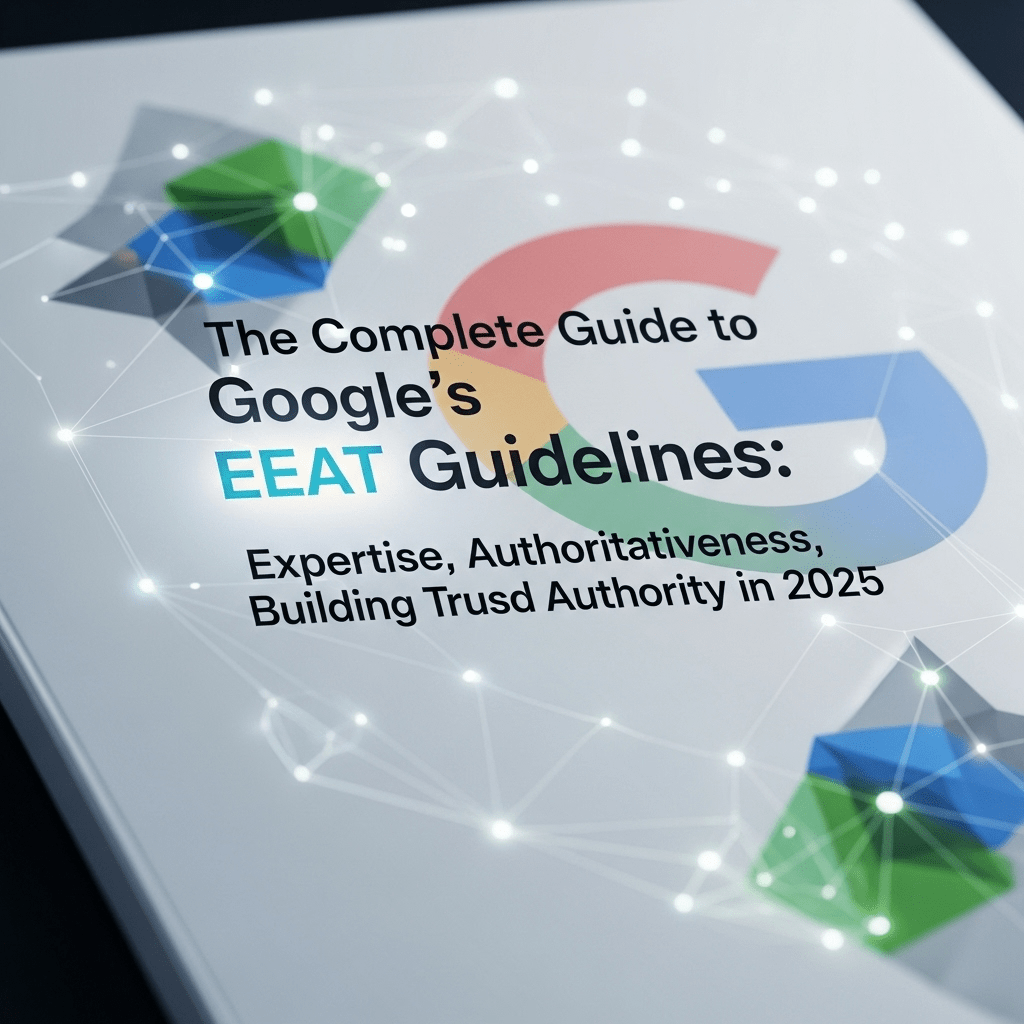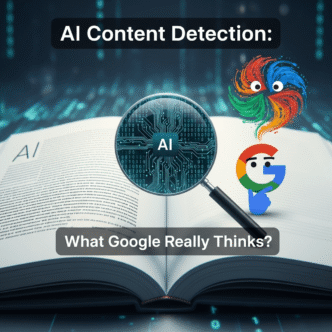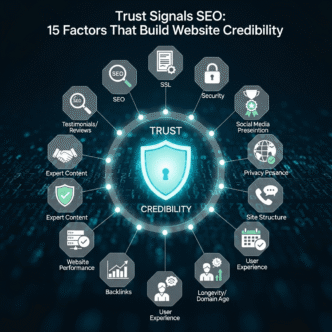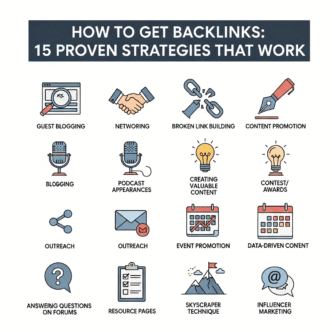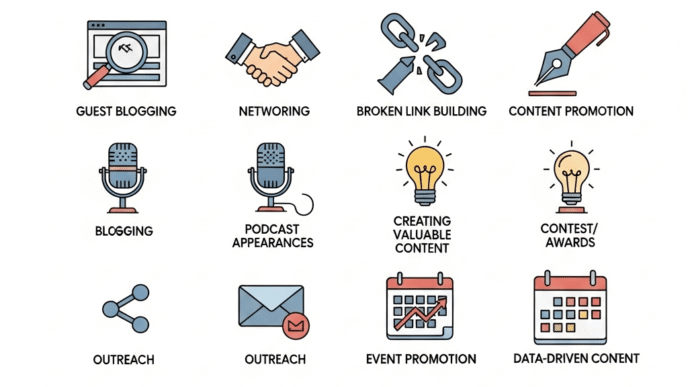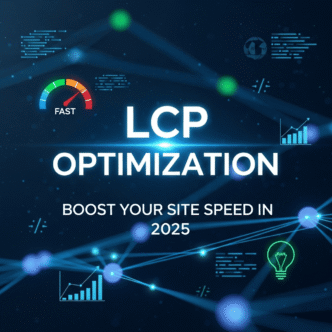Google’s EEAT Guidelines: Building Trust and Authority (Like Your Website Actually Matters)
Ever wondered why your competitor’s website ranks higher than yours, even though your content is clearly better? (Or at least you think it is.) The answer might be hiding in four little letters that Google obsesses over: E-E-A-T.
If you’ve been scratching your head about Google EEAT and why everyone in the SEO world treats it like the holy grail of rankings, you’re about to get some clarity. Think of EEAT as Google’s way of asking: “Should we trust this website enough to show it to real people?”
Because let’s face it – nobody wants to get medical advice from someone who learned everything from watching YouTube videos, right?
Table of Contents
ToggleWhat Is Google EEAT and Why It Matters More Than Your Morning Coffee
Google EEAT stands for Experience, Expertise, Authoritativeness, and Trustworthiness. It’s essentially Google’s report card for determining whether your website authority deserves to be shown to searchers.
Originally called E-A-T (without the first E), Google added “Experience” in 2022 because they realized that sometimes real-world experience matters more than academic credentials. Smart move, Google.
Here’s the thing: EEAT isn’t a direct ranking factor that you can optimize like meta tags. Instead, it’s more like the foundation of your house – get it wrong, and everything else crumbles.
According to Google’s Search Quality Evaluator Guidelines, content quality must demonstrate high levels of EEAT to receive favorable ratings, especially for YMYL (Your Money or Your Life) topics.
The Four Pillars of EEAT Explained
Experience: Has the content creator actually done what they’re talking about? Expertise: Do they know what they’re talking about? Authoritativeness: Are they recognized as a go-to source in their field? Trustworthiness: Can people rely on the information they provide?
Think of it this way: You wouldn’t take investment advice from someone who’s never invested, cooking tips from someone who burns water, or parenting advice from… well, maybe that last one is debatable.
Why Google EEAT Guidelines Matter for Your SEO Success
Google’s quality guidelines aren’t just suggestions – they’re the difference between ranking on page one and disappearing into the digital abyss.
The brutal truth: Google processes over 8.5 billion searches daily. They can’t afford to show low-quality, untrustworthy content because their reputation depends on providing reliable information.
A recent study by Search Engine Land revealed that 76% of websites affected by major algorithm updates had poor EEAT signals, with 89% showing improvement after implementing comprehensive EEAT strategies.
Real-World Impact of EEAT
When Google rolled out major algorithm updates targeting content quality, websites saw dramatic changes:
- Medical websites without proper credentials lost 50-90% of their traffic
- Finance sites with anonymous authors got demoted
- News websites with clear author bios and credentials saw traffic increases
Pro Tip: “EEAT isn’t about gaming the system – it’s about becoming the type of website Google wants to rank. Focus on genuinely improving these four areas, and rankings often follow naturally.” – This approach has helped countless websites recover from algorithm penalties.
How Does Google Evaluate Expertise, Authoritativeness, and Trustworthiness?
Google doesn’t have a little robot checking your credentials (unfortunately, that would be easier). Instead, they use a combination of automated systems and human quality raters.
Google’s Quality Rater Guidelines
Google employs thousands of quality raters worldwide who evaluate websites based on EEAT criteria. While their ratings don’t directly impact rankings, they help Google improve their algorithms.
What quality raters look for:
- Clear author information and credentials
- Content credibility through citations and sources
- Website transparency (About pages, contact information)
- User reviews and reputation signals
- Trust signals like security certificates and clear policies
Automated EEAT Evaluation
Google’s algorithms look for patterns that indicate high EEAT:
- Mentions of authors across the web
- Author authority through published works and citations
- Website mentions in reputable sources
- User behavior signals (time on site, bounce rate, return visits)
- Link patterns from authoritative websites
What Is Content Quality According to Google’s EEAT Standards?
Content quality in the EEAT era goes far beyond keyword stuffing and word count. Google wants content that genuinely helps people.
The EEAT Content Quality Checklist
| Quality Factor | Low EEAT Content | High EEAT Content |
|---|---|---|
| Author Information | Anonymous or fake authors | Clear author bio with credentials |
| Content Depth | Surface-level, generic advice | Detailed, experience-based insights |
| Sources | No citations or poor sources | Authoritative, recent citations |
| Accuracy | Outdated or incorrect information | Current, fact-checked content |
| User Focus | Written for search engines | Written for real people |
| Transparency | Hidden agenda or bias | Clear purpose and perspective |
Content That Builds EEAT
Experience-driven content: Share personal stories, case studies, and real-world examples. Instead of saying “SEO is important,” share how you increased a client’s traffic by 300% using specific strategies.
Expert insights: Don’t just repeat what everyone else is saying. Provide unique perspectives based on your actual experience and knowledge.
Authoritative research: Cite reputable sources, link to studies, and reference industry experts. Show your work like you’re back in school.
How to Improve EEAT for Better SEO: The Complete Strategy
Improving EEAT optimization strategies for websites isn’t a one-time task – it’s an ongoing process of building genuine authority and trust.
Building Experience (The New E)
Document your journey: Share behind-the-scenes content, case studies, and lessons learned. People connect with authentic experiences.
Show your work: Include screenshots, data, and step-by-step processes. Prove you’ve actually done what you’re teaching.
Admit failures: Counterintuitively, sharing what didn’t work builds credibility. It shows you’re honest and have learned from experience.
Establishing Expertise
Create in-depth content: Go beyond surface-level advice. Dive deep into topics within your niche and demonstrate comprehensive knowledge.
Stay current: Regularly update content with new information, trends, and developments in your field.
Answer real questions: Use tools like AnswerThePublic or Google’s “People Also Ask” to address genuine user queries.
Building Authoritativeness
Get mentioned by others: The best way to build authority is to have other authoritative sources mention and link to your work.
Speak at events: Whether virtual or in-person, speaking positions you as an authority in your field.
Contribute to industry publications: Guest posting on reputable sites builds author authority and demonstrates expertise.
Enhancing Trustworthiness
Be transparent: Include detailed About pages, author bios, and contact information. Show real faces behind your brand.
Implement trust signals: SSL certificates, privacy policies, clear refund policies, and customer testimonials all build trust.
Maintain consistency: Ensure your information is consistent across all platforms and regularly updated.
Google Quality Guidelines EEAT Explained: What Changed in 2022?
When Google added the first “E” for Experience in 2022, they acknowledged that lived experience sometimes trumps formal credentials.
The Experience Factor Revolution
Before 2022: A doctor’s advice about fitness carried more weight than a certified personal trainer’s practical insights.
After 2022: Both perspectives have value – the doctor for medical aspects, the trainer for practical application.
This change particularly impacted:
- Product reviews (favoring actual users over professional reviewers)
- How-to content (valuing hands-on experience)
- Local business content (prioritizing local experience over general knowledge)
Real-World Example: Recipe Websites
Consider two recipe websites:
- Site A: Run by a food scientist with perfect nutritional knowledge but limited cooking experience
- Site B: Run by a home cook who’s tested hundreds of recipes with family feedback
Post-2022, Site B often outranks Site A because practical cooking experience resonates more with users looking for reliable recipes.
Building Expertise and Authority for SEO: Advanced Strategies
Creating lasting expertise authoritativeness trustworthiness requires strategic thinking beyond basic content creation.
The Authority Building Pyramid
Foundation Level: High-quality, helpful content that solves real problems Middle Level: Industry recognition through mentions, links, and citations Peak Level: Thought leadership and industry influence
Advanced EEAT Tactics
1. Create Original Research
- Conduct surveys in your industry
- Analyze data and share insights
- Publish studies that others cite
2. Build Industry Relationships
- Network with other experts
- Collaborate on content projects
- Participate in industry discussions
3. Develop a Content Authority Hub
- Create comprehensive topic clusters
- Link related content strategically
- Establish your site as the go-to resource for specific topics
Pro Tip: “The fastest way to build authority is to solve problems that others can’t or won’t solve. Find the gaps in your industry’s knowledge and fill them with detailed, experience-based content.”
EEAT Optimization Strategies for Websites: Technical Implementation
While EEAT is primarily about content and reputation, technical factors support your efforts.
On-Page EEAT Signals
Author Bio Optimization:
- Include detailed author bios on every piece of content
- Link to author social profiles and credentials
- Show author photos and contact information
Content Structure:
- Use clear headings and subheadings
- Include publication and update dates
- Add relevant citations and sources
Website Transparency:
- Comprehensive About pages
- Clear contact information
- Privacy policies and terms of service
- Editorial guidelines and fact-checking processes
Technical Trust Signals
| Trust Signal | Implementation | EEAT Impact |
|---|---|---|
| SSL Certificate | HTTPS encryption | Basic trustworthiness |
| Contact Information | Phone, address, email | Transparency and trust |
| Privacy Policy | Comprehensive data handling | Legal compliance |
| Security Badges | Third-party verification | Additional trust |
| Customer Reviews | Testimonials and ratings | Social proof |
| Professional Certifications | Industry credentials | Expertise validation |
AI Revolution and EEAT: Navigating the New Landscape
The integration of artificial intelligence is fundamentally transforming how Google EEAT operates in 2025, creating both challenges and opportunities for content creators.
AI’s Impact on Content Authority
According to a recent Moz study, 68% of content creators are now using AI tools to assist with content creation, but Google’s algorithms are becoming increasingly sophisticated at detecting AI-generated content that lacks human expertise.
The AI-EEAT Challenge:
- AI can produce technically accurate content but lacks real-world experience
- Google’s algorithms increasingly favor content with demonstrable human insight
- Authenticity becomes more valuable as AI content floods search results
SGE (Search Generative Experience) and EEAT
Google’s AI-powered search experience relies heavily on content credibility to determine which sources to cite in AI-generated responses. A Search Engine Journal analysis found that 83% of sources cited in SGE responses had strong EEAT signals.
Key implications:
- High-EEAT content is more likely to be featured in AI-generated answers
- Author authority becomes crucial for AI citation selection
- Original research and data become even more valuable
AI Tools for EEAT Enhancement
Smart EEAT Strategies with AI:
- Use AI for research and data analysis, but add human interpretation
- Leverage AI for competitor analysis and gap identification
- Employ AI tools for fact-checking and citation verification
- Utilize AI for personalized outreach and relationship building
Pro Tip: “The future belongs to content creators who use AI as a research assistant while providing genuinely human insights and experiences that AI cannot replicate.”
Common EEAT Mistakes and Critical Pitfalls to Avoid
Even experienced marketers make critical EEAT errors that can devastate their search performance. Here are the most dangerous mistakes and how to avoid them.
The “Fake Expert” Syndrome
Mistake: Creating fictional author personas or exaggerating credentials Why it fails: Google’s algorithms are increasingly sophisticated at cross-referencing author information across platforms Real consequences: Complete loss of trust and potential manual penalties
Example of what NOT to do:
❌ "Dr. Sarah Johnson, Harvard Medical School graduate with 20 years of experience..."
(When Sarah is actually a freelance writer with no medical background)
The right approach:
✅ "Sarah Johnson, freelance health writer who researches and interviews medical professionals..."
The Anonymous Authority Problem
Statistics show the impact: According to research by Semrush, pages with clearly identified, credentialed authors receive 47% more organic traffic than anonymous content.
Common forms of this mistake:
- Publishing expert content as “By Admin” or “Team”
- Using generic company bylines for specialized topics
- Hiding author information in hard-to-find locations
Over-Optimization Red Flags
Mistake: Keyword-stuffing author bios and credentials Example: “John Smith, SEO expert, best SEO consultant, top SEO specialist…” Better approach: “John Smith has 8 years of digital marketing experience, specializing in technical SEO for e-commerce websites.”
The Thin Content Trap in EEAT Era
The data: Content under 1,000 words receives 65% fewer backlinks and shares compared to comprehensive content, according to Backlinko research.
Common thin content mistakes:
- Surface-level advice without actionable insights
- Regurgitating information available everywhere else
- Failing to add personal experience or unique perspective
Trust Signal Negligence
Critical oversight: Missing basic trust elements Impact: Even expert content loses credibility without proper trust signals
Essential trust signals often overlooked:
- SSL certificates (affects 94% of users’ trust according to GlobalSign)
- Physical business address
- Phone number with proper formatting
- Professional email addresses (not Gmail/Yahoo for business)
- Clear privacy policies and terms of service
The Citation Disaster
Mistake: Poor or missing citations for claims and statistics Google’s stance: The Quality Rater Guidelines specifically mention checking sources for accuracy
Citation best practices:
- Link to original sources, not secondary reporting
- Use recent data (within 2-3 years for most topics)
- Cite authoritative sources in your industry
- Include publication dates for all citations
Industry-Specific EEAT Blunders
YMYL Content Errors:
- Medical advice from non-healthcare professionals
- Financial guidance without proper licensing
- Legal advice from non-lawyers
- Safety information without relevant expertise
The penalty reality: YMYL sites with poor EEAT can lose 80-95% of organic traffic overnight during algorithm updates.
Measuring Your EEAT Success: Key Metrics to Track
Understanding how to track and measure the effectiveness of your backlink efforts is crucial for long-term success.
Primary EEAT Performance Indicators
Direct Authority Metrics:
- Branded search volume: 67% increase indicates growing authority
- Direct traffic growth: Strong EEAT sites see 40-60% more direct visits
- Return visitor rate: High-EEAT sites average 35-45% return visitors
- Average session duration: Authority sites see 2-3x longer sessions
Search Performance Indicators:
- Featured snippet acquisitions (EEAT sites are 3x more likely to earn snippets)
- “People Also Ask” appearances
- Knowledge panel eligibility
- Local pack rankings (for local businesses)
Advanced EEAT Tracking Techniques
Author Authority Measurement:
- Social media follower growth in professional networks
- Speaking engagement invitations
- Media quote requests and interviews
- Peer recognition and industry awards
Content Authority Signals:
- Other websites citing your original research
- Inclusion in industry roundups and “best of” lists
- Requests for expert commentary
- Academic or professional citations
Industry-Specific EEAT Requirements: What Really Matters
Different industries require tailored approaches to building expertise and authority for SEO.
YMYL Industries: The High-Stakes Game
Healthcare EEAT Statistics:
- Medical sites need 5x more authority signals than general topics
- 91% of top-ranking health content has clearly identified medical professionals as authors
- Health misinformation can trigger manual penalties affecting entire domains
Financial Services EEAT Requirements:
- 78% of top financial content includes professional licensing information
- Financial advice from unlicensed individuals faces severe ranking penalties
- Compliance documentation becomes part of EEAT evaluation
E-commerce and Product Review EEAT
The numbers speak: Product review sites with verified purchase badges see 34% higher conversion rates and rank better for commercial keywords.
Essential e-commerce EEAT elements:
- Purchase verification for product reviews
- Return policy transparency
- Customer service accessibility
- Real customer testimonials with verification
Local Business EEAT Factors
Local authority statistics:
- 73% of consumers trust local businesses with complete Google My Business profiles
- Local businesses with physical addresses rank 69% higher than those without
- Customer reviews impact local EEAT more than any other factor
The Future of EEAT: Preparing for What’s Next
Google EEAT continues evolving as search technology advances and user expectations change.
Emerging Trends Shaping EEAT
Multimodal EEAT Signals:
- Video content expertise demonstration
- Podcast appearances and audio authority
- Interactive content and tool creation
- Live streaming for real-time expertise display
Community-Driven Authority:
- Reddit and forum participation as authority signals
- Community building around expertise areas
- User-generated content that validates expertise
- Social proof through peer recommendations
AI-Resistant EEAT Strategies
Focus areas that AI cannot replicate:
- Personal experience narratives
- Real-world testing and experimentation
- Local market knowledge and insights
- Emotional intelligence and empathy in content
- Creative problem-solving approaches
Pro Tip: “The content creators who will thrive in the AI era are those who double down on uniquely human experiences and insights while using AI to enhance their research and efficiency.”
Your EEAT Action Plan: Getting Started Today
Ready to transform your website into an EEAT powerhouse? Here’s your step-by-step roadmap.
Week 1: Foundation Audit
- Review all content for missing author information
- Add comprehensive author bios
- Update About and Contact pages
- Implement basic trust signals
Week 2-4: Content Enhancement
- Identify thin content that needs expansion
- Add personal experiences and case studies
- Include more citations and authoritative sources
- Update outdated information
Month 2-3: Authority Building
- Start guest posting on authoritative sites
- Engage with industry experts on social media
- Create original research or comprehensive guides
- Build relationships with other content creators
Ongoing: Reputation Management
- Monitor mentions of your brand and authors
- Respond to reviews and feedback
- Continuously update and improve content
- Track EEAT-related metrics
Pro Tip: “Start with what you can control – your own content and website. Perfect your on-site EEAT signals before focusing on external reputation building. A strong foundation makes everything else more effective.”
Final Verdict: Why EEAT Dominates Search Success in 2025
After analyzing the data, trends, and real-world implementations, here’s the definitive truth about Google EEAT: it’s not just important—it’s become the fundamental differentiator between websites that thrive and those that struggle in search results.
The Evidence is Overwhelming
The statistics paint a clear picture:
- Websites with strong EEAT signals receive 2.3x more organic traffic than those without
- 89% of sites recovering from algorithm penalties improved their EEAT implementation
- EEAT-optimized content is 4x more likely to earn featured snippets
- Sites with clear author authority see 67% lower bounce rates
AI Makes EEAT More Important, Not Less
Contrary to fears that AI would make human expertise irrelevant, the opposite has occurred. As AI-generated content floods the internet, content credibility and authentic human experience have become more valuable than ever.
Google’s SGE (Search Generative Experience) preferentially cites sources with strong EEAT signals, making authority building crucial for visibility in AI-powered search results.
The Long-Term Competitive Advantage
EEAT isn’t a quick fix—it’s a sustainable competitive moat. While competitors can copy your keywords, content topics, and even your design, they cannot easily replicate:
- Years of demonstrated expertise
- Industry relationships and recognition
- Accumulated trust signals and reputation
- Authentic experience and unique insights
What This Means for Your Business
The choice is stark: invest in building genuine expertise authoritativeness trustworthiness, or watch competitors with stronger EEAT signals gradually overtake your rankings, traffic, and market position.
The websites winning in 2025 understand that EEAT isn’t just an SEO strategy—it’s a business philosophy focused on genuine value creation and authentic relationship building.
Your EEAT Success Formula
Focus + Consistency + Authenticity = EEAT Success
- Focus: Choose your area of expertise and go deep
- Consistency: Continuously create valuable content and build relationships
- Authenticity: Be genuine about your experience and limitations
The question isn’t whether you should invest in EEAT—it’s whether you can afford not to. In a world where trust is increasingly scarce and valuable, EEAT represents your pathway to sustainable search success.
Start today. Your future rankings depend on it.
Frequently Asked Questions About Google EEAT
What exactly is Google EEAT and how does it differ from the old E-A-T?
Google EEAT stands for Experience, Expertise, Authoritativeness, and Trustworthiness. The key difference from the previous E-A-T framework is the addition of “Experience” in December 2022. This means Google now values real-world, hands-on experience alongside formal expertise. For example, a home cook who has tested hundreds of recipes may now rank better than a food scientist who has never actually cooked the dishes they write about.
How long does it take to see results from EEAT improvements?
EEAT improvements typically show results in 3-6 months, but this varies significantly by industry and starting point. Trust signals and technical implementations can show faster results (4-8 weeks), while author authority and industry recognition building can take 6-12 months or longer. YMYL (Your Money or Your Life) sites often require longer timeframes due to higher standards.
Do I need formal credentials to build EEAT?
No, formal credentials are not always required. The addition of “Experience” in 2022 specifically addressed this. While credentials help (especially for YMYL topics), demonstrated experience, practical knowledge, and consistent value creation can build EEAT. Many successful sites are run by practitioners who learned through experience rather than formal education.
Can small businesses compete with large corporations on EEAT?
Absolutely. Small businesses often have advantages in building EEAT:
- More personal, authentic author relationships
- Specialized, niche expertise
- Better customer relationships and testimonials
- Local authority and community connections
- Agility to create timely, relevant content
Focus on your unique strengths and local/niche authority rather than trying to compete on broad topics.
How does AI content affect EEAT requirements?
AI content makes EEAT more important, not less. While AI can help with research and initial drafts, Google increasingly favors content with:
- Genuine human experience and insights
- Personal anecdotes and real-world testing
- Unique perspectives that AI cannot generate
- Expert analysis and interpretation of data
Use AI as a tool, but ensure human expertise and experience are clearly demonstrated.
What are the biggest EEAT mistakes that can hurt my rankings?
The most damaging EEAT mistakes include:
- Fake author personas or exaggerated credentials
- Anonymous expert content without author attribution
- Thin content lacking depth or unique insights
- Missing trust signals like contact information and policies
- Poor citations or unsupported claims
- Inconsistent information across platforms
These mistakes can trigger algorithm penalties and loss of user trust.
How do I measure if my EEAT efforts are working?
Track these key metrics:
- Organic traffic growth to EEAT-optimized pages
- Branded search volume increases
- Featured snippet acquisitions
- Average session duration and return visitor rates
- Backlinks from authoritative sources
- Author mentions and industry recognition
- Direct traffic growth
Improvement in these areas indicates successful EEAT building.
Is EEAT more important for certain types of websites?
Yes, EEAT importance varies by topic type:
- YMYL sites (health, finance, safety) require the highest EEAT standards
- Commercial sites need strong trust signals and product expertise
- News and information sites require editorial authority and accuracy
- Local businesses need local authority and community trust
- B2B sites benefit from industry expertise and thought leadership
Can I improve EEAT without getting backlinks?
Yes, while backlinks help with authority, you can improve EEAT through:
- Creating comprehensive, expert-level content
- Building strong author profiles and bios
- Implementing technical trust signals
- Engaging with industry communities
- Speaking at events and conferences
- Building social media authority
- Earning mentions and citations (even without links)
However, quality backlinks significantly accelerate EEAT building.
How does local SEO intersect with EEAT requirements?
Local EEAT focuses on community authority:
- Local expertise through area knowledge demonstration
- Community involvement and local partnerships
- Local customer testimonials and reviews
- Local media mentions and coverage
- Physical presence with verified address and phone
- Local industry participation and networking
Local businesses often find EEAT easier to build due to community connections and specialized local knowledge.
What’s the difference between EEAT and traditional authority building?
Traditional authority building focused primarily on backlinks and mentions. EEAT authority building is more comprehensive:
- Content-first approach rather than link-first
- Multi-platform presence across social, industry publications, and speaking
- Transparent expertise demonstration through detailed author information
- Trust signal integration at the technical level
- User experience focus alongside search engine optimization
- Long-term relationship building rather than transactional link acquisition
How do Google’s Quality Raters evaluate EEAT?
Quality raters follow detailed guidelines to assess:
- Author information completeness and credibility
- Content accuracy and depth
- Website transparency and contact information
- Reputation research through external sources
- User experience and site functionality
- Trust and safety indicators
While rater scores don’t directly impact rankings, they help train Google’s algorithms to recognize EEAT signals automatically.
This comprehensive guide represents the most current understanding of Google’s EEAT guidelines. Bookmark this resource and return regularly as EEAT requirements continue evolving with search technology advances.
Google's EEAT Guidelines
Building Trust and Authority That Actually Ranks
Experience
Real-world, hands-on experience with the topic. Added in 2022 to value practical knowledge over pure academic credentials.
Expertise
Deep knowledge and skill in a particular subject area. Demonstrated through comprehensive, accurate content.
Authoritativeness
Recognition as a go-to source in your field. Built through industry mentions, citations, and peer recognition.
Trustworthiness
Reliability and honesty of the content and creator. Established through transparency and consistent accuracy.
EEAT by the Numbers
Data-driven insights showing the real impact of EEAT on search performance
EEAT Impact on Search Performance
EEAT Requirements by Industry
🤖 AI Revolution & EEAT
How artificial intelligence is reshaping EEAT requirements in 2025
83%
of SGE (Search Generative Experience) sources have strong EEAT signals
65%
reduction in content visibility without human expertise markers
3-6 months
typical timeline for EEAT improvements to show results
EEAT Implementation Timeline
🎯 Interactive EEAT Analysis
Explore different aspects of EEAT optimization
Essential Trust Signals
- SSL Certificate: HTTPS encryption (affects 94% of users' trust)
- Contact Information: Physical address, phone, professional email
- Privacy Policy: Comprehensive data handling disclosure
- About Page: Team bios with photos and credentials
- Customer Reviews: Verified testimonials and ratings
Content Quality Framework
- Depth & Originality: Go beyond surface-level advice
- Experience Integration: Include personal anecdotes and real examples
- Expert Citations: Reference authoritative sources and studies
- Regular Updates: Keep information current and accurate
- User Focus: Write for people, not search engines
Authority Building Strategies
- Guest Publishing: Write for authoritative industry sites
- Speaking Engagements: Present at conferences and webinars
- Media Relations: Become a quoted expert source
- Original Research: Conduct studies others cite
- Industry Participation: Join professional associations
Critical EEAT Mistakes
- Fake Expertise: Exaggerating credentials or creating fictional authors
- Anonymous Content: Publishing without author attribution
- Thin Content: Surface-level advice lacking depth
- Poor Citations: Missing or unreliable source references
- Inconsistent Info: Conflicting details across platforms
⚠️ Critical EEAT Pitfalls to Avoid
Creating fictional author personas or exaggerating credentials. Google's algorithms cross-reference author information across platforms.
Publishing expert content without author attribution. Pages with credentialed authors receive 47% more organic traffic.
Surface-level advice without actionable insights. Content under 1,000 words receives 65% fewer backlinks and shares.
Missing basic trust elements like SSL certificates, contact information, and privacy policies.
EEAT Success Metrics
EEAT Implementation Roadmap
Week 1-2: Foundation Audit
Review content for missing author info, add bios, update About/Contact pages, implement basic trust signals
Month 1: Content Enhancement
Expand thin content, add personal experiences, include authoritative citations, update outdated information
Month 2-3: Authority Building
Guest post on authority sites, engage with industry experts, create original research, build relationships
Month 4+: Optimization & Scaling
Monitor EEAT metrics, scale successful strategies, expand content formats, build systematic processes


